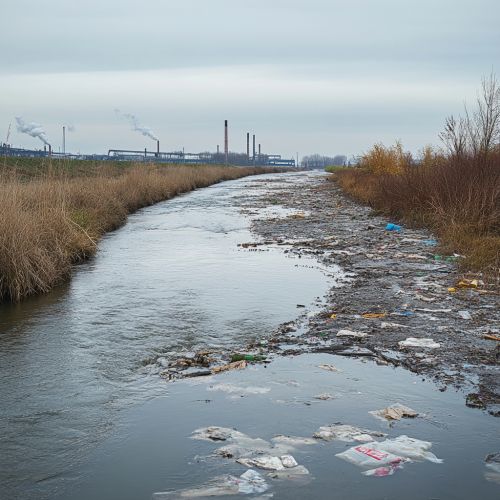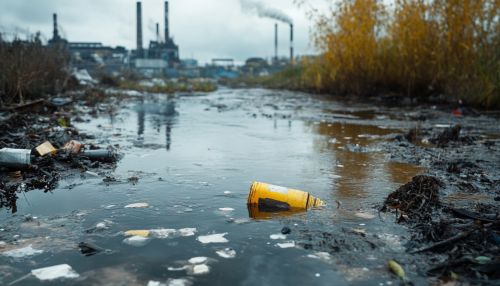Polychlorinated biphenyls (PCBs): Difference between revisions
(Created page with "== Introduction == Polychlorinated biphenyls (PCBs) are a group of synthetic organic chemicals that contain 209 individual chlorinated compounds known as congeners. These compounds were widely used in industrial and commercial applications due to their non-flammability, chemical stability, and insulating properties. PCBs were first synthesized in the late 19th century and became commercially significant in the 20th century. However, due to their environmental persistenc...") |
No edit summary |
||
| Line 21: | Line 21: | ||
Once released into the environment, PCBs can accumulate in soil, sediments, and aquatic systems. They are known to bioaccumulate in wildlife, particularly in aquatic organisms such as fish and marine mammals. This bioaccumulation can lead to biomagnification, where higher concentrations of PCBs are found in organisms at higher trophic levels. | Once released into the environment, PCBs can accumulate in soil, sediments, and aquatic systems. They are known to bioaccumulate in wildlife, particularly in aquatic organisms such as fish and marine mammals. This bioaccumulation can lead to biomagnification, where higher concentrations of PCBs are found in organisms at higher trophic levels. | ||
[[Image:Detail-104443.jpg|thumb|center|Polluted river with industrial background and visible contamination.|class=only_on_mobile]] | |||
[[Image:Detail-104444.jpg|thumb|center|Polluted river with industrial background and visible contamination.|class=only_on_desktop]] | |||
== Health Effects == | == Health Effects == | ||
Latest revision as of 18:53, 18 November 2024
Introduction
Polychlorinated biphenyls (PCBs) are a group of synthetic organic chemicals that contain 209 individual chlorinated compounds known as congeners. These compounds were widely used in industrial and commercial applications due to their non-flammability, chemical stability, and insulating properties. PCBs were first synthesized in the late 19th century and became commercially significant in the 20th century. However, due to their environmental persistence and potential health risks, the production of PCBs was banned in many countries by the late 1970s.
Chemical Structure and Properties
PCBs are biphenyl molecules with chlorine atoms substituted at various positions. The general chemical formula for PCBs is C12H10-nCln, where 'n' can range from 1 to 10. The degree of chlorination and the position of chlorine atoms on the biphenyl rings determine the physical and chemical properties of each congener. PCBs are typically oily liquids or solids that are colorless to light yellow and have no distinct odor.
PCBs are hydrophobic and lipophilic, meaning they tend to accumulate in fatty tissues of living organisms. Their chemical stability and resistance to degradation make them persistent in the environment. These properties, combined with their low solubility in water, contribute to their bioaccumulation and biomagnification in the food chain.
Historical Use and Production
PCBs were manufactured primarily by the Monsanto Company under the trade name Aroclor, although other companies also produced them under different names. They were used in a variety of applications, including as dielectric fluids in transformers and capacitors, heat transfer fluids, plasticizers in paints and cements, and additives in lubricants and sealants.
The production of PCBs peaked in the 1960s and 1970s, with an estimated 1.5 million tons produced worldwide. Their use was widespread due to their versatility and effectiveness in industrial applications. However, concerns about their environmental and health impacts led to regulatory actions and eventual bans.
Environmental Impact
PCBs are persistent organic pollutants (POPs) that can remain in the environment for decades. They are resistant to natural degradation processes such as photolysis, hydrolysis, and biodegradation. PCBs can be transported long distances through the atmosphere and water currents, leading to widespread contamination.
Once released into the environment, PCBs can accumulate in soil, sediments, and aquatic systems. They are known to bioaccumulate in wildlife, particularly in aquatic organisms such as fish and marine mammals. This bioaccumulation can lead to biomagnification, where higher concentrations of PCBs are found in organisms at higher trophic levels.


Health Effects
Exposure to PCBs can occur through ingestion, inhalation, or dermal contact. The primary route of human exposure is through the consumption of contaminated food, particularly fish and other seafood. PCBs are classified as probable human carcinogens by the International Agency for Research on Cancer (IARC) and have been linked to various adverse health effects.
Chronic exposure to PCBs can lead to a range of health issues, including immune system suppression, reproductive and developmental problems, neurobehavioral and cognitive deficits, and endocrine disruption. PCBs can also affect the liver, skin, and thyroid gland. The severity of health effects depends on the level and duration of exposure, as well as the specific congeners involved.
Regulatory Actions and Remediation
In response to the growing evidence of the environmental and health risks associated with PCBs, many countries implemented regulatory measures to restrict their production and use. In the United States, the Environmental Protection Agency (EPA) banned the manufacture of PCBs in 1979 under the Toxic Substances Control Act (TSCA). Similar bans and restrictions were enacted in other countries and regions, including the European Union and Japan.
Remediation of PCB-contaminated sites involves various strategies, including excavation and removal of contaminated soil, dredging of sediments, and in situ treatment methods such as bioremediation and chemical oxidation. The choice of remediation technique depends on the extent of contamination, site characteristics, and potential risks to human health and the environment.
Analytical Methods for Detection
The detection and quantification of PCBs in environmental and biological samples require sophisticated analytical techniques. Gas chromatography (GC) coupled with mass spectrometry (MS) is the most commonly used method for PCB analysis due to its high sensitivity and specificity. Other techniques include high-performance liquid chromatography (HPLC) and enzyme-linked immunosorbent assays (ELISA).
Sample preparation is a critical step in PCB analysis and typically involves extraction, cleanup, and concentration procedures. Solid-phase extraction (SPE) and liquid-liquid extraction (LLE) are commonly used methods for isolating PCBs from complex matrices. The choice of analytical method depends on the sample type, the concentration of PCBs, and the required detection limits.
Global Distribution and Monitoring
PCBs have been detected in various environmental compartments, including air, water, soil, and biota, across the globe. Their persistence and ability to undergo long-range atmospheric transport have resulted in their presence in remote regions such as the Arctic and Antarctic.
Monitoring programs have been established to assess the levels and trends of PCBs in the environment and to evaluate the effectiveness of regulatory measures. These programs involve the collection and analysis of samples from various media, including air, water, sediments, and biological tissues. Data from monitoring programs are used to inform policy decisions and to identify areas where further action may be needed.
Alternatives and Substitutes
Following the ban on PCBs, industries sought alternative substances that could provide similar properties without the associated environmental and health risks. Several substitutes have been developed, including mineral oils, silicone oils, and synthetic esters. These alternatives are used in applications such as transformers, capacitors, and heat transfer systems.
The selection of a suitable substitute depends on various factors, including the specific application, technical requirements, and regulatory considerations. While some alternatives have been found to be effective, ongoing research and development are necessary to ensure their safety and performance.
Conclusion
Polychlorinated biphenyls (PCBs) have had a significant impact on both the environment and human health due to their widespread use and persistence. Despite the regulatory measures and bans implemented to reduce their presence, PCBs continue to pose challenges due to their long-lasting nature and global distribution. Continued efforts in monitoring, remediation, and the development of safer alternatives are essential to mitigate the risks associated with PCBs and to protect environmental and public health.
